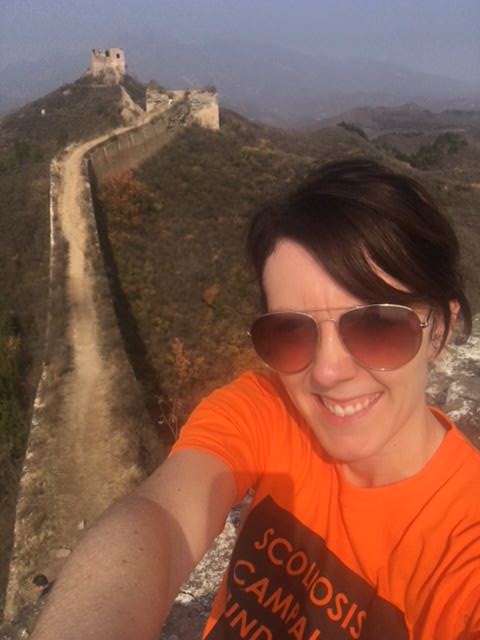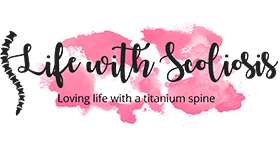
Preparing for Scoliosis Surgery: From a Caretakers Perspective

If someone close to you is about to undergo scoliosis surgery, as someone on the “other side” it can be just as daunting to know how best to prepare and what to expect.
For this special blog post, I have teamed up with Sanna – she has recently been in the caretaker role for her sister, who underwent scoliosis surgery Summer of 2018.
She can offer invaluable advice, from a caretaker’s point of view on how to best prepare for surgery day and recovery both in the hospital and in the months following at home.
Preparing for Scoliosis Surgery: From a Caretakers Perspective
Last summer, in 2018, I was the caretaker for my sister who had spinal fusion surgery.
My name is Sanna and my younger sister had fusion surgery to correct her scoliosis. The surgery lasts on average about 4 hours and the hospital stay is a handful of nights. I was present at the hospital and helped with at home care following the surgery. I slept in the hospital each night and spent a lot of time with the nurses caring for my sister.
From doing so, there was a lot I learned in my role as caretaker. If you are going to be in that same position, or would like to share this with someone who will be your caretaker, here is some advice I can offer as you prepare for surgery day. I have created some checklists for packing at the end of this article!
Packing for the hospital
When packing for the hospital, you should bring plenty of pillows, blankets and a few towels from home.
You need fluffy pillows and you need thin pillows – find a variety of sizes to bring. The blankets should be a variety of weights, from a very warm one to a thin sheet. Make sure everything is freshly washed before you leave!
First let’s talk pillows. You will need the pillows after surgery for propping yourself up in bed. My sister often found she was most comfortable when being supported by pillows. We also used rolled up towels for more solid support. I took some hand towels and rolled them tightly to make an even support system for propping the back of the neck or under the arms.
You need some of the pillows you bring to be matching sets, so that you can prop the body evenly and balanced. A pillow under the knees will relieve any pressure on the lower back. The hospital bed moves up and down so you can experiment a bit to find the best positions. Flatten the pillows or fluff and stack the pillows for more or less support until you find what is just right.
You will need a variety of blankets as the hospital can get chilly but then all of a sudden warm. It was nice to have soft blankets and comfortable pillows that smell like home! The hand towels were amazing for making small, dense rolls that you could tuck right where support is needed.
Pack some different forms of entertainment, we brought an Amazon Fire Stick to plug into the TV so that we would have Netflix to watch. We also brought a book to read out loud! That was fun to have, as sometimes the TV position isn’t comfortable for the person recovering from surgery. We also brought a Bluetooth speaker to play podcasts and some music.
Medication
A very important thing you can do for your loved one after surgery is to track their medication and be on top of timing! The goal is to work as a team with the nurses and hospital staff. Bring a notebook and pen to create a log and write down every time the nurse administers a drug, what the drug is, and what time it was given. If you need anxiety medication after surgery along with your pain meds do not be afraid to ask the nurse for that!
You can take full advantage of advanced western medicine while in the hospital. The second or third day after surgery I had to help remind the nurses to administer the pain medication on time so that the current pain medication wouldn’t stop working. 30 minutes before the medication was going to wear off, I would go find a nurse and ask for another dose.
While waiting on the nurse to come in we would have a snack or a meal. It is much easier on the patient’s stomach to eat something before taking pain meds. Avoid eating processed sugar like chocolate, ice cream, or sugary drinks, soda etc. as sugar causes inflammation in the body. Just a few crackers will do if you aren’t hungry. The stomach can become irritated if there is no food when pain meds are given.
Food
In terms of food – seriously skip the processed sugar and junk food! As the caretaker you are fetching and choosing the food for your loved one. I’d suggest bringing some healthy snacks so you don’t cave at the vending machine! We had organic apple juice, crackers, Goldfish, granola bars, and apple slices with peanut butter in our room. Anything that doesn’t need refrigeration was great to have immediately on hand. The caretaker should lead by example and eat healthy with the patient!
Physical Therapy
Following the surgery, you can expect the Physical Therapist (PT) to visit the room on average once a day. If I could go back and do it again, I would have asked the PT to schedule time to help us get into the car for the ride home on discharge day. That may be difficult to schedule but if you can plan ahead and have their help and supervision you may feel more confident about getting into the car!
The Journey Home
Lots of pillows and blankets for the car ride home are necessary. Choose a position that works best for you, it really is a personal preference. Trust what your body is asking for. There are medical transport services that you can book but we had a bad experience using one and looking back on it, I truly think you could make it just as well in your own vehicle. It would be nice to have the Physical Therapist help you get into the car though!
Post Hospital Care
Once at home there were a few things we needed to be comfortable. We had two memory foam wedge pillows ordered from Amazon, a matching set. We would use the matching set to prop the mattress up evenly so you could sit up a bit. We placed the wedge pillows underneath the mattress instead of on top of it, making it much easier to get in and out of bed. Consider that you will need a walker to get around for a while.
We had to rearrange some furniture in our house to make wide walking spaces and remove any rugs that could get hung up. Keep your pain management plan going while you are at home. The caretaker should assume full responsibility for the pain management medications at home and keep things on track safety. My sister was so happy to be home! It is wonderful to get back to your house and rest comfortably in your own bed.
This surgery isn’t easy but you will get through it, I saw firsthand how incredible the human body is in its ability to heal.
You will heal and you will feel good, repeat that statement often!
Any anxiety is normal for the person having the surgery and also for the caretaker to feel during this process. Many difficult experiences in life bring us closer together, you and your caretaker will have a deepened bond for the rest of your life. It is pure love you give to each other while recovering from the surgery.
You are not in this alone. Trust me when I say, everyone one comes out on the “other side” eventually and you will be one million times stronger than you were before.
POST SCOLIOSIS SURGERY CHECKLIST
- Variety of firm and fluffy pillows
- Variety of blankets
- Two Hand towels and one or two regular towels
- Notebook and Pen to track medications/timing
- Amazon Fire Stick, Apple TV or any streaming device
- Bluetooth Speaker
- Books you enjoy for reading out loud
- Healthy snacks for in the room
- Organic fruit juice (avoid soda)
- Wet bathroom wipes (flushable)
- Comfortable clothes and supportive shoes for the caretaker
When you leave the hospital make sure you have…
- A walker
- Slidable pads for the bed (patient lays on the pad and you can lift/slide the patient around – you need to bring a few of these pads home from the hospital!)
- Medications for at home
- Your notebook with the pain management plan and daily log
Thank you Sanna for taking the time to write this post, I’m sure it will help many people facing scoliosis surgery and it’s interesting to see things from the carers perspective.
When I had my surgery, my mum cared for me and I’m sure she would have found this checklist very useful! For further reading on my own experiences, check out my posts Preparing for Scoliosis Surgery and Scoliosis Surgery: What to bring to hospital.
If you would like to share your scoliosis story, or collaborate on a future post, please contact me!
You can also reach out to Sanna over on Instagram.
Follow my blog on Bloglovin’
Pin it!


I had scoliosis surgery in 2010 and blog about my experiences living with scoliosis. My aim is to raise awareness of scoliosis and help and inspire others with the condition.

